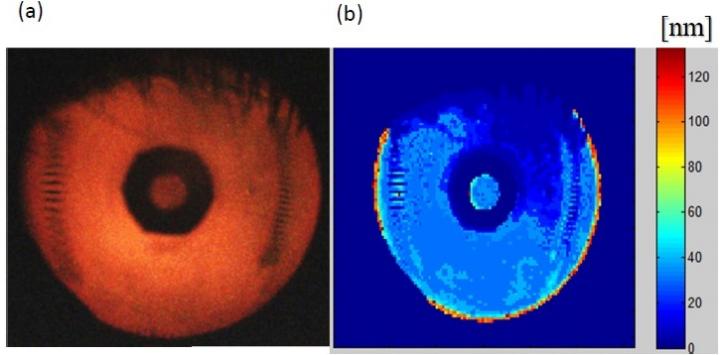

The Tear Film Imager captures a raw image (a) and also generates a thickness map (b) derived from the color information at each pixel. This can be used to distinguish the tear film's inner layers.
Credit: AdOM Advanced Optical Methods Ltd.
Researchers have developed a new non-invasive optical imaging system that promises to improve diagnosis and treatments for dry eye disease. Dry eye, which often causes irritation and blurred vision, occurs when there is instability in the inner layer of the tear film that protects the outside of the eye.
Today, most cases of dry eye are diagnosed using patient questionnaires, which may be subjective and cannot typically be used to identify the cause of the disease. Objective methods for examining the tear film tend to be invasive and cannot track rapid changing dynamics, which are altered with every blink.
“Up to 60 percent of ophthalmology office visits are due to dry eye, pointing to the need for a non-invasive and highly accurate device for diagnosis in the office setting,” said research team leader Dr. Yoel Arieli from AdOM Advanced Optical Methods Ltd. in Israel. “Our Tear Film Imager is the first device that can be used in the ophthalmology or optometry setting to image the tear film and distinguish its inner layers with nanometer resolution.”
In the Optical Society (OSA) journal Applied Optics, researchers describe the device's ability to perform spectral measurements across a large field of view in a matter of seconds. They report that the imager can acquire fast and consistent measurements from human eyes even when blinking.
The research study was performed at AdOM Advanced Optical Methods laboratory. The proof of concept, unique method and design that enable measurement of ultra-thin tear layers with nanometer resolution were developed by AdOM's development team led by Dr. Yoel Cohen.
Improving diagnosis through imaging
“For the diagnosis of dry eye disease, there have been few significant advancements over recent years,” said Dr. Arieli. “We collaborated with academic and practicing physicians who diagnose and treat dry eye to develop an instrument that can be integrated into a clinical setting while very accurately imaging the tear film inner layers, which can be used to diagnose dry eye and understand its cause.”
The new instrument uses an eye-safe halogen light to illuminate the eye and then analyzes the full spectrum of light reflection over time and space. These spectral measurements are used to reconstruct the structures found in the front of the eye, allowing accurate measurement of the tear film inner layers, especially the aqueous sublayer. This sublayer plays an important role in dry eye but has been difficult to analyze with other methods.
“The broadband illumination source and fine details available from spectral analysis provide nanometer-level insight into subtle changes in each tear film layer and sublayer,” said Dr. Arieli. “These measurements are completed automatically in just 40 seconds.”
After demonstrating a resolution of 2.2 nanometers on a mock tear film, the researchers tested the instrument's ability to take measurements on the human eye with no intervention while the patient was blinking. “The device worked impressively and presents no risk because it is non-invasive and uses a simple light source,” said Dr. Arieli. “It not only measured the tear film consistently including blinks every few seconds, but the measurements correlated well with other partially invasive, established dry eye diagnostic techniques.”
The Tear Film Imager has been used in two clinical studies in Israel and Canada, examining dry eye diagnosis with the device and dry eye treatments, which can be precisely evaluated with the imager. The researchers say that future studies could help inform better dry eye treatments, improve surgical outcomes and lead to more accurate fitting of contact lenses. They are also planning to use the Tear Film Imager in larger studies with more diverse groups of patients to set base levels for both healthy eyes and people with dry eye.
###
Disclaimer: The TFI and the information provided about it have not been evaluated by the U.S. Food and Drug Administration. The TFI has yet to receive any regulatory approvals.
Paper: Y. Cohen, S. Epshtein, A. Harris, R. Gefen, L. Kagemann, Y. Arieli, “A tear film imager for dynamic mapping of the human tear film,” Applied Optics, 58, 29, 7987-7995 (2019).
DOI: https:/
About Applied Optics
Applied Optics publishes in-depth peer-reviewed content about applications-centered research in optics. These articles cover research in optical technology, photonics, lasers, information processing, sensing and environmental optics.
About The Optical Society
Founded in 1916, The Optical Society (OSA) is the leading professional organization for scientists, engineers, students and business leaders who fuel discoveries, shape real-life applications and accelerate achievements in the science of light. Through world-renowned publications, meetings and membership initiatives, OSA provides quality research, inspired interactions and dedicated resources for its extensive global network of optics and photonics experts. For more information, visit osa.org.
Media Contact:












